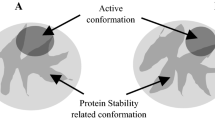Abstract
The specific activity of immobilized alkaline phosphatase can be considerably increased by exposure to a brief temperature pulse. The thus-pulsed preparations show a hysteresis of higher activity at room temperature varying from 10 min to several days, depending upon their pretreatment and the conditions of the reaction mixture during the pulse. In almost all cases the pulse can be repeated many times to increase the activity.
Similar content being viewed by others
References
Pittner, F., (1982),Appl. Biochem. Biotechnol. 7, 195.
Bessey, O. A., Lowry, H. O., and Brach, M. J. (1946),J. Biol. Chem. 164, 321.
Weetall, H. (1976), inMethods in Enzymology, Vol. 44, Mosbach, K., ed., Academic Press, New York, p. 139.
Pittner, F., Miron, T., Pittner, G., and Wilchek, M. (1980),J. Solid-Phase Biochem. 5(3), 167–179.
Pittner, F., Miron, T., Pittner, G., and Wilchek, M. (1980),J. Solid-Phase Biochem. 5(3), 147–166.
Pittner, F. (1981),Appl. Biochem. Biotechnol. (1981),Appl. Biochem. Biotechnol. 6, 153–166.
Author information
Authors and Affiliations
Rights and permissions
About this article
Cite this article
Pittner, F. Temperature-dependent behavior of immobilized alkaline phosphatase II. temperature pulse. Appl Biochem Biotechnol 7, 259–268 (1982). https://doi.org/10.1007/BF02798304
Received:
Accepted:
Issue Date:
DOI: https://doi.org/10.1007/BF02798304




